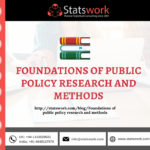I am planning to develop a theory? Which methodology would be better and analyses tool that I should use?
A theory is constructed for explaining some phenomena, situations in the real world or any behaviour type. This theory helps to understand any problems or issues of a new finding and make a conclusion depending on the most important feature. Sometimes, theories are used for forecasting situation or any phenomenon (Fawcett & Downs, 2015). In the case of a research paper or a dissertation, the theory is formulated to explain, predict and realise the phenomena which are assumed to happen in reality. In support of this theory, the theoretical framework is structured for introducing and describing the theory that can explain the reason for a reason for the research problem (Dawson, 2019).
On the other hand, research methodology is considered as a significant part of a research paper. It includes the description of various ways and means for conducting the research. The principal aim of this research methodology is to explain the techniques which are useful or can be useful for obtaining the data or information as that will be expected to find out on behalf of the aim and objectives of the research (Bowen, et al., 2017). A relevant and useful research methodology is very important to support the theory which is needed to be constructed. Inspite of performing a thorough literature review, the research paper is mainly based on the findings made by relevant research methodology (Gordon, 2015).
There are three types of research methodologies which are utilised in constructing a theory. Those are qualitative, quantitative and mixed. The mixed research methodology includes both quantitative and qualitative research methodologies. Therefore, to understand the role of the research methodology in constructing a theory, it is required to emphasize both the qualitative and quantitative research methodologies (Dawson, 2019).
In the case of a qualitative study, the main aim indicates to understand social phenomena by investigations and interpretation of various meaning as attached to the research. In this case, primary objectives are making sense to find out the phenomena in the real world. The key principle is based on subjectivity instead of making interpretations (Pandey, 2015). The theory will be developed during or after the research work is conducted. In this case, the inductive process is followed. In this process, the researcher starts to collect the data relevant to the topic of interest. In the second step, data analysis and data observation is performed based on the similar pattern and finally based on the observations or findings of the data, a theory can be developed (Mngadi, 2018).
In the case of quantitative study, the enquiry is developed depending on testing thee theory which made up of various variables and those are measured based on the numbers. Further, the variables are analysed with a suitable data analysis tool. It is needed to check whether the result performed by the tool and the prediction of the theory will be matched or not in this quantitative research methodology (Dawson, 2019). In this case, the core principle is based on the objectivity and the study is found to associate with positivist or post-positivist or both types of the research paradigm. The research method is generally carried out by following deductive processes. In the case of the deductive process, the hypothesis can be developed depending on the existing theory. The researcher mostly shows the interest and makes decision or interpretation based on the inferences of data. Thus, in this case, the researcher mainly tests his or her hypothesis based on the existing theories (Mngadi, 2018).
In some cases, the mixed research methodology is required to prefer where both the qualitative and quantitative research process is needed to follow in constructing a theory. In the mixed methodology, mainly sequential and explanatory approached are used for evaluating the concept that has to be observed for constructing the theory (Bowen, et al., 2017). The explanatory sequential design includes two different phases. First one refers to the initial quantitative instrument phase and it is followed by the second phase of qualitative data collection (Bowen, et al., 2017). The qualitative phase is found to build directly on the result interpreted from the quantitative phase.
Data analysis plays an important role in conducting research methodology. This process indicates the underlying process which is employed by the researcher for gathering necessary data in research. The researcher should mention the tool which is utilised to collect the required data. At first, the researcher needs to select the sample size depending on which the research methodology will be performed. The sample is needed to choose in such a way so that it would not provide any bias information based on the selected population (Bowen, et al., 2017). Sample size should be taken based on the prevalence and precision of the data measurement. Generally, good and maximum sample size can be around 10% of the population and it should not exceed 1000. Further, the minimum sample size can be preferred to be 100 (Dawson, 2019). There are several ways based on which data collection is performed with the sample size. Those are online or offline surveys, questionnaires, direct interviews etc. In the case of quantitative methodology, data collection is performed by surveys and questionnaires including close-ended questions. In the case of qualitative methodology, generally, observations, open-ended survey or the interview are performed to gather the required amount of data for the research. Qualitative data collection is found to consist of more number of open-ended questions and the descriptive type answers which may have little or no numeric variables (Mngadi, 2018). It has been observed that qualitative data is an excellent way of gaining insight within the thoughts and behaviour of the audience.
Hence, the theory is mainly constructed based on the inductive or deductive approach of different research methodologies. The quantitative and qualitative research methodology can be carried out by considering suitable data collection methods. The sample size is also needed to choose so that it can support the measurement for constructing the theory with an unbiased way. Open-ended and closed-ended questions are developed based on the research methodology so that an effective theory can be developed from the research performed.
Above blog referred here
References
- Bowen, P., Rose, R. & Pilkington, A., 2017. MIXED METHODS-THEORY AND PRACTICE. SEQUENTIAL, EXPLANATORY APPROACH. International Journal of Quantitative and Qualitative Research Methods, 5(2), pp. 10-27.
- Dawson, C., 2019. Introduction to Research Methods 5th Edition: A Practical Guide for Anyone Undertaking a Research Project. 1st ed. New York: Robinson.
- Fawcett, J. & Downs, F., 2015. The Relationship Between Theory and Reserach. The Relationship of Theory and Research , 1(1), pp. 1-4.
- Gordon, H., 2015. Strategic Information Systems: Concepts, Methodologies, Tools, and Applications: Concepts, Methodologies, Tools, and Applications. New York: IGI Global .
- Mngadi, A., 2018. The role of theory in research and practice. s.l.:GRIN Verlag.
- Pandey, P., 2015. RESEARCH METHODOLOGY: TOOLS AND TECHNIQUES. 1st ed. Romania: Bridge Center.
[wce_code id=1]


 Previous Post
Previous Post Next Post
Next Post